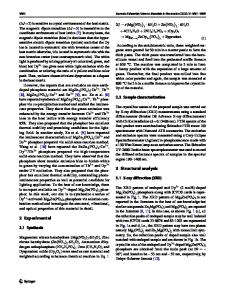SrAl 2 O 4 :Eu 2+ ,Dy 3+ nanobelts: Synthesis by combustion and properties of long-persistent phosphorescence
- PDF / 171,165 Bytes
- 5 Pages / 584.957 x 782.986 pts Page_size
- 75 Downloads / 332 Views
SrAl2O4:Eu2+,Dy3+ polynary complex nanobelts with long-persisting phosphorescence were synthesized via a facile but efficient combustion method followed by a postannealing reaction at temperature above 900 °C. All the samples emit greenish-yellow light from the d-f transition of Eu2+, and moreover, their wavelength redshifts with increasing calcination temperature since the increase in crystal size and crystalline quality causes a large average optical path and high crystal symmetry, respectively. The decay constant of the sample calcined at low temperature is smaller than that of the one annealed at high temperature owing to the presence of higher densities and depths of electron traps donated by host defects, and the initial brightness of the sample calcined at low temperature is relatively low owing to the small volume fraction from relatively low crystallinity.
I. INTRODUCTION
Since the first discovery of carbon nanotubes, there have been significant research efforts to controllable fabrication of nanostructured materials with well-defined shapes and dimensions due to their novel properties and promising applications in electronics, mechanics, physics, and chemistry arising from shape-specific and quantum size effects.2–4 In the past, these researches have concentrated on the compounds with simple composition. Comparatively speaking, little work has been performed on the fabrication of technologically and practically important polynary complex nanostructures because it is generally difficult to match the reactivity of the different metal precursors during synthesis.5–7 SrAl2O4:Eu2+,Dy3+, served as a completely new generation of persistent luminescent phosphor, has attracted much interest due to its high luminescent intensity, longlasting time, chemical stability, and environmental capability. The afterglow (or phosphorescence) phosphor has been widely used in traffic signs, emergency signs, watches, clocks, paintings, and textile printing as well as in “glow in the dark” toys.8,9 However, it is more significant that the nanostructured phosphors with long afterglow will have many potential tremendous applications in biological and medical science,10–12 e.g., they can be used for in vitro and in vivo imaging while no excitation light is needed because some afterglow phosphors can last long time after activation. In addition, they are also used as a light source for photodynamic therapy (PDT) activation to enable PDT 1
a)
Address all correspondence to this author. e-mail: [email protected] DOI: 10.1557/jmr.2011.94 J. Mater. Res., Vol. 26, No. 17, Sep 14, 2011
http://journals.cambridge.org
Downloaded: 18 Mar 2015
for deep cancer treatment, in which a photosensitizer is activated by afterglow light to produce singlet oxygen for cancer cell destruction. At present, many effective techniques, including solid state reaction,8,13 sol–gel,14,15 coprecipitation,16–18 combustion,19–22 reverse microemulsion method,23 and so forth, have been developed to synthesize the phosphors. However, the phosphor synthesized by solid sta
Data Loading...











